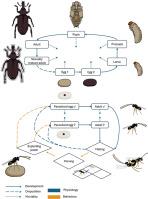Individual behaviour and temperature: simulation of an insect parasitoid population
IF 3.2
3区 环境科学与生态学
Q2 ECOLOGY
引用次数: 0
Abstract
The impact of temperature on the physiology of insects has been extensively studied. Conversely, we know much less about the impact on insect behaviour. In the context of climate change, we urgently need to better understand the effect of temperature on animal behaviour, and to include these effects in predictive population models. To evaluate the importance of such inclusions, we created two temperature-based population dynamics simulation models of parasitoid’s life cycle. The first one is based on development, mortality and oviposition rate data, while the second model includes those plus behavioural components: mating, host searching and host exploitation. Including behaviours in the population dynamics model resulted in slightly lower predicted populations, but the change was small, suggesting that including behaviours did not increase the prediction efficiency. This is expected in temperature conditions under which the species has evolved, because individuals can behave optimally. Behaviours and development traits all had different thermal performance curves, with optimal temperature and tolerance range varying. Therefore, while the inclusion of behaviours did not change much the dynamics of simulated populations at intermediate temperature conditions, this would no longer hold true when temperatures become more extreme. In the context of climate change, extreme temperatures are expected to occur more frequently, thus strongly affecting insect behavioural performance, and likely resulting in changes in population dynamics. Consequently, behavioural components should be considered when studying more extreme conditions, because physiological components alone overlook certain effects of temperature on the life cycle of an individual.

个体行为和温度:昆虫寄生性种群的模拟
温度对昆虫生理的影响已被广泛研究。相反,我们对昆虫行为的影响知之甚少。在气候变化的背景下,我们迫切需要更好地了解温度对动物行为的影响,并将这些影响纳入预测种群模型。为了评估这些包裹体的重要性,我们建立了两个基于温度的寄生蜂生命周期种群动态模拟模型。第一个模型是基于发育、死亡率和产卵率数据,而第二个模型包括那些附加的行为成分:交配、寻找宿主和利用宿主。在种群动态模型中加入行为导致预测种群数量略低,但变化很小,表明加入行为并没有提高预测效率。这在物种进化的温度条件下是可以预料到的,因为个体可以表现得最优。行为和发育性状具有不同的热性能曲线,最适温度和耐受性范围各不相同。因此,虽然在中等温度条件下,包括行为并没有改变模拟种群的动态,但当温度变得更加极端时,这将不再成立。在气候变化的背景下,极端温度预计会更频繁地发生,从而强烈影响昆虫的行为表现,并可能导致种群动态的变化。因此,在研究更极端的条件时应该考虑行为因素,因为生理因素本身忽略了温度对个体生命周期的某些影响。
本文章由计算机程序翻译,如有差异,请以英文原文为准。
求助全文
约1分钟内获得全文
求助全文
来源期刊

Ecological Modelling
环境科学-生态学
CiteScore
5.60
自引率
6.50%
发文量
259
审稿时长
69 days
期刊介绍:
The journal is concerned with the use of mathematical models and systems analysis for the description of ecological processes and for the sustainable management of resources. Human activity and well-being are dependent on and integrated with the functioning of ecosystems and the services they provide. We aim to understand these basic ecosystem functions using mathematical and conceptual modelling, systems analysis, thermodynamics, computer simulations, and ecological theory. This leads to a preference for process-based models embedded in theory with explicit causative agents as opposed to strictly statistical or correlative descriptions. These modelling methods can be applied to a wide spectrum of issues ranging from basic ecology to human ecology to socio-ecological systems. The journal welcomes research articles, short communications, review articles, letters to the editor, book reviews, and other communications. The journal also supports the activities of the [International Society of Ecological Modelling (ISEM)](http://www.isemna.org/).
 求助内容:
求助内容: 应助结果提醒方式:
应助结果提醒方式:


